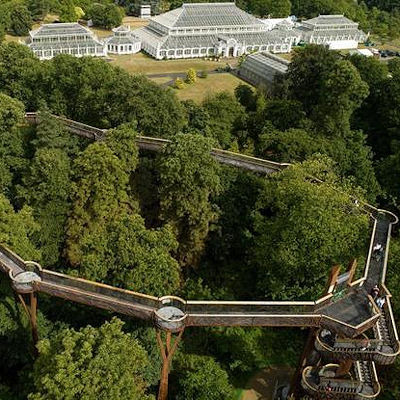
Like us on Facebook
PLACE NAMES


 
|
|
Kew
|

|
|
|
Kew is a suburban district in the London Borough of Richmond upon Thames, 1.5 miles (2.4 km) north-east of Richmond and 7.1 miles (11.4 km) west by south-west of Charing Cross; its population at the 2011 Census was 11,436.
The earliest written reference to Kew is thought to be contained in Julius Caesar's Gallic Wars, as the location where the Roman Army forded the Thames in 54 BC although this has been disputed. The name Kew is a combination of two words: the Old French kai (landing place; "quay" derives from this) and Old English hoh (spur of land). The land spur is formed by the bend in the Thames. The name was recorded in 1327 as Cayho.
Kew is the location of the Royal Botanic Gardens ("Kew Gardens"), now a World Heritage Site, which includes Kew Palace. Kew is also the home of important historical documents such as Domesday Book, which is held at The National Archives.
Successive Tudor, Stuart and Georgian monarchs maintained links with Kew. During the French Revolution, many refugees established themselves there and it was the home of several artists in the 18th and 19th centuries.
Since 1965 Kew has incorporated the former area of North Sheen which includes St Philip and All Saints, the first barn church consecrated in England. It is now in a combined Church of England ecclesiastical parish with St Luke's Church, Kew.
Today, Kew is an expensive residential area because of its suburban hallmarks. Among these are sports-and-leisure open spaces, schools, transport links, architecture, restaurants, no high rise buildings, modest road sizes, trees and gardens. Most of Kew developed in the late 19th century, following the arrival of the District line of the Underground. Further development took place in the 1920s and 1930s when new houses were built on the market gardens of North Sheen and in the first decade of the 21st century when considerably more river-fronting flats and houses were constructed by the Thames on land formerly owned by Thames Water.
Henry V developed a Carthusian monastery to the south west of where Kew Observatory now stands.
Charles Somerset, 1st Earl of Worcester was granted lands at Kew in 1517. When he died in 1526 he left his Kew estates to his third wife, Eleanor, with the remainder to his son George. In 1538 Sir George Somerset sold the house to Thomas Cromwell, who resold it for the same amount to Charles Brandon, 1st Duke of Suffolk. Brandon had probably already inhabited Kew during the life of his wife Mary Tudor, the daughter of Henry VII and widow of the French king Louis XII. According to John Leland's Cygnea Cantio ("Swan Song"), she stayed in Kew (which he refers to as "Cheva") for a time after her return to England.
One of Henry VIII's closest friends, Henry Norris, lived at Kew Farm, which was later owned by Elizabeth I's favourite, Robert Dudley, Earl of Leicester. This large palatial house on the Thames riverbank predated the royal palaces of Kew Palace and the White House. Excavations at Kew Gardens in 2009 revealed a wall that may have belonged to the property.
In Elizabeth's reign, and under the Stuarts, houses were developed along Kew Green. West Hall, which survives in West Hall Road, dates from at least the 14th century and the present house was built at the end of the 17th century.
Elizabeth Stuart, daughter of James I, was given a household at Kew in 1608.
Queen Anne subscribed to the building of the parish church on Kew Green, which was dedicated to St Anne in 1714, three months before the queen's death.
The Hanoverians maintained the strongest links with Kew, in particular Princess Augusta who founded the botanic gardens and her husband Frederick, Prince of Wales who lived at the White House in Kew. Augusta, as Dowager Princess of Wales, continued to live there until her death in 1721. Frederick commissioned the building of the first substantial greenhouse at Kew Gardens.
In 1721 the future George III and Queen Charlotte moved into the White House at Kew. They established their main summer court at Kew from the 1760s and 1770s. Queen Charlotte died at the Dutch House in Kew in 1818.
William IV spent most of his early life at Richmond and at Kew Palace, where he was educated by private tutors.
|
 Feel free to Email me any additions or corrections Feel free to Email me any additions or corrections
LINKS AVAILABLE TO YOUR SITE
| |





